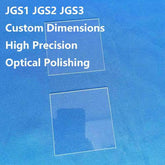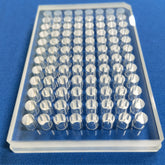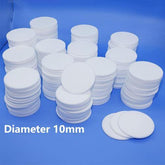Classification of impurities in quartz products in semiconductor technology
Manufacturers of quartz products typically classify impurities based on the specific application environments. This classification of impurities can be broadly categorized into several types: visible impurities (such as bubbles, gas lines, color spots, and nodules), heavy metals, alkali metals, and hydroxyl groups.
- Visible impurities
In addition to bubbles, the presence of other visible impurities is not permitted in qualified quartz products. The presence of colour spots and nodules is indicative of the unqualified status of the quartz product, and such products should be prohibited from entering the market.

The detection of bubbles is subject to a number of different standards. However, the presence of bubbles within quartz glass is an inevitable consequence of the production process, regardless of the specific techniques used. The specifications set forth by the quartz glass industry typically stipulate that the total number of bubbles with a diameter less than 0.5 mm and greater than 0.1 mm should not exceed 3 per cubic centimetre. Furthermore, the presence of broken bubbles is expressly prohibited, while bubbles with a diameter of less than 0.1 mm are not discernible to the naked eye in natural light.
This has led to the establishment of two distinct sets of bubble detection standards: one under natural light and another under intense illumination. Generally, larger diameter bubbles can adversely affect the mechanical strength of the quartz product, potentially leading to surface defects or rupture during heating, whereas smaller bubbles have a negligible impact on the performance. Therefore, when selecting quartz materials, it is advisable to choose products that exhibit nearly no visible bubbles under natural light conditions.

- Alkali metals
In semiconductor manufacturing processes, particular attention is paid to the overall content of alkali metals such as potassium, sodium, and lithium. Due to their reactive nature, alkali metals pose significant challenges in semiconductor fabrication, and a high content of alkali metals within the quartz products can lead directly to contamination and failure of semiconductor devices. Currently, GE-214 products commonly used in the semiconductor industry stipulate maximum allowable concentrations for potassium, sodium, and lithium at less than 0.6-0.7 ppm each, with a total alkali metal content not exceeding 2 ppm.

- Heavy metals
The incorporation of heavy metals into the manufacturing process of semiconductor products does not typically result in adverse effects. The high-temperature resistance of quartz tubes and apparatus with a high aluminium content is significantly enhanced.
- Hydroxylgroups
The hydroxyl content in quartz glass exhibits significant variability due to the diverse techniques employed in processing quartz sand into quartz glass. In particular, the gas refining method, which is predominantly utilized within the semiconductor industry, typically yields quartz materials with hydroxyl concentrations ranging from 150 to 300 ppm. The influence of hydroxyl content on these materials can be attributed to two primary factors. Firstly, hydroxyl groups present in high-hydroxyl materials tend to be formed under elevated temperature conditions, effectively encapsulating deleterious alkali metals during semiconductor fabrication and mitigating their potential contamination of wafers. Secondly, the presence of hydroxyl groups alters the bonding structure of SiO2, thereby diminishing the thermal stability of the material and significantly reducing its temperature resistance.

Consequently, for high-temperature semiconductor processes (exceeding 1000 degrees Celsius), it is imperative to consider the actual impact of hydroxyl content on material performance; this may necessitate selecting alternative processing methods beyond gas refining, or employing dehydroxylation techniques such as vacuum resistance furnace heating.
According to the industry standard of quartz products, there are some specific requirements for the hydroxyl content of semiconductor quartz products, and these standards categorize such quartz materials into T grade and B grade, with a content of hydroxyl controlled within 30-50ppm.






